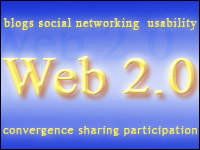
It was a generally interesting day of keynote speeches at the Web 2.0 conference Wednesday, although a couple of the presentations were real mind-benders.
One keynote laid out how developers can use core concepts of gaming apps to create better products.
Others dealt with creating infectious action, going viral successfully, and data and Web 3.0.
Appdevs Got Game
Amy Jo Kim, cofounder and CEO of ShuffleBrain, laid out seven core concepts that game developers use to create compelling products. These can be used to create other kinds of apps as well, she posited.
One is know your players and design for their personal and social needs. “Ask yourself who’s playing and what’s their social style,” Kim said.
The second is to build fun, pleasure and satisfaction into the core activity loop through providing positive reinforcements.
Third, appdevs should design differently for the three key stages of the player lifecycle — newbies, regulars who’ve learned the ropes, and enthusiasts or power users, Kim said.
Fourth, build a system that’s easy to learn and hard to master. Fifth, use game mechanics to help users towards mastery; sixth, find flow and design; and seventh, learn how to use intrinsic value and extrinsic rewards.
About Infectious Action
Getting a Web-based business up to speed is heavily dependent on getting people to do something — sign up for your site or click on a link, for instance. But how do you motivate people to take action?
Jennifer Lynn Aaker, the general Atlantic professor of marketing at Stanford University, spoke about a model she created listing four simple skills that help campaigns take off.
First, focus on a single goal; second, do something to grab people’s attention; third, tell a story as an asset; and fourth, enable others to act by making it easy for them to click on a link, for example, Aaker said.
Going Viral Successfully
Essentially, Aaker’s approach will help make a campaign viral.
However, there’s no one-size-fits-all solution to going viral successfully, Jonah Peretti, founder and CEO of Buzzfeed and cofounder of the Huffington Post, stated.
The key to going viral is making your site about your users and not just about your content, Peretti said.
“Think of your social content not as something you want people to take away in their head but as a way for your users to share and react to the content,” Peretti explained. “That way, you’ll get a much bigger viral lift with people passing on the content.”
Whither Web 3.0?
Social content is nothing but data, and data is going to be the platform of Web 3.0, Reid Hoffman, founder and executive chairman of LinkedIn, said.
That data can be generated explicitly by consumers entering social network sites and posting information, or implicitly when consumers turn on their mobile phones, Hoffman elaborated.
This information isn’t the same as data mashups, Hoffman pointed out.
“What’s different here is that everyone is now a participant … where you’re producing information one way or the other, and that production on a mass basis can be mashed up in a much more fundamental way,” Hoffman explained.
M-Commerce Dreams of Yesterday
Then came a presentation on the future of online commerce by Osama Bedier, vice president of platform, mobile and new ventures at Google.
The future of commerce on the Web will consist of all-digital mobile payments, Bedier said. Consumers will be able to use their credit, debit or gift cards at any store anywhere; and they’ll have an interoperable identity so they don’t have to sign up for different cards at different stores, Bedier added.
This will bring us back to the kind of service Bedier gets back in his home town in Egypt, he remarked. The grocery store clerk greets customers by name, knows their purchasing patterns, recommends delicacies customers might like and will send away for items not in stock and deliver them to the customers’ homes.
So let’s see — we invest tons of money in technology to get the same kind of service we used to get 50 years ago, and still get from small groceries in developing nations without smartphones or wireless infrastructure. Guess Marty McFly was headed in the wrong direction through the old time tunnel.
Lost in Space
Stripped of the technobabble, the keynote by Jennifer Magnolfi, senior integration architect for programmable environments at Herman Miller, consisted basically of taking standard architectural ideas and adding a high-tech verbal spin.
“Users of space are its co-designers,” Magnolfi said. “Environments can communicate something about you and what’s important to you.” Any mother with a teenaged son knows that, which is why she’ll yell at him to clean up his room — she just doesn’t like his design and layout and what it communicates about the kid to her.
At the Microsoft Envisioning Lab, users are given tools to change the properties of their physical space, Magnolfi stated. For example, they get programmable wall panels “which allowed us to control their opacity and would allow us to control the perception of depth of space.”
Some technoverbiage about designing the panels followed but hey, haven’t we all worked in cubicles that can be rearranged by dragging around panels?
Space is an open source platform, Magnolfi stated.
OK, so does that come under the GPL? And if we abuse space will the Man Upstairs send down a few floods or plagues in retribution? Open source fans need to know.





















































